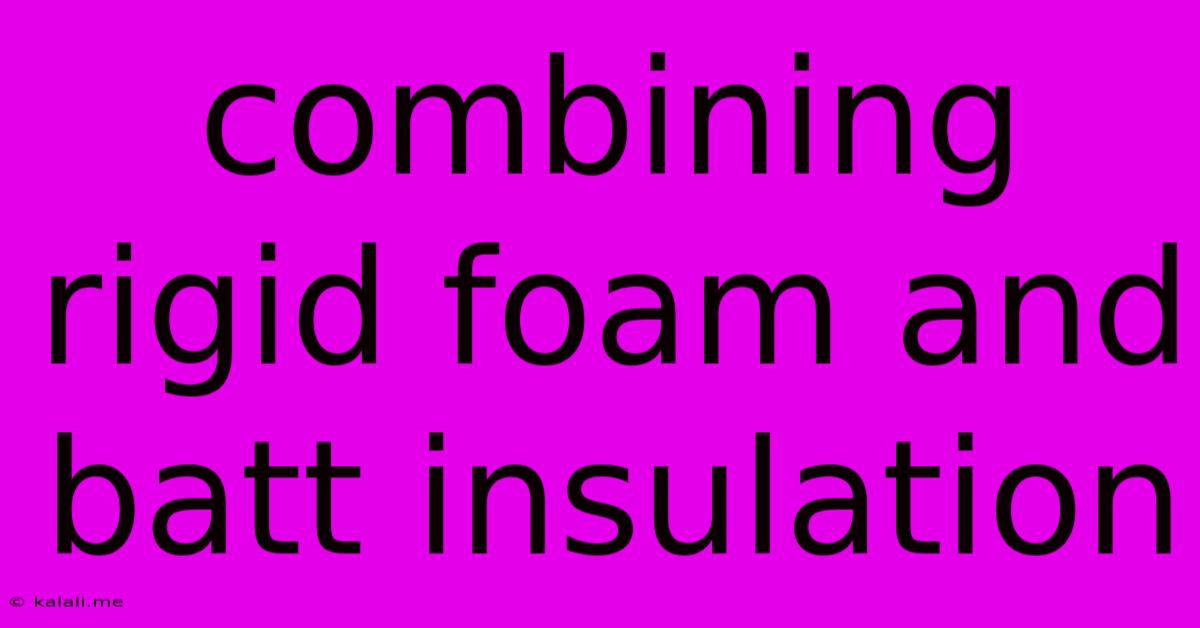Combining Rigid Foam And Batt Insulation
Kalali
Jun 02, 2025 · 3 min read

Table of Contents
Combining Rigid Foam and Batt Insulation: A Powerful Insulation Duo
Meta Description: Learn how combining rigid foam and batt insulation can significantly improve your home's energy efficiency. This guide explores the benefits, optimal application methods, and considerations for this powerful insulation duo.
Choosing the right insulation is crucial for a comfortable and energy-efficient home. While many homeowners opt for just one type of insulation, combining rigid foam and batt insulation offers a synergistic approach that maximizes thermal performance and addresses specific building challenges. This article delves into the advantages, best practices, and considerations for this powerful combination.
Understanding the Advantages of Combining Insulation Types
Using both rigid foam insulation and batt insulation leverages the unique strengths of each material, leading to superior results compared to using either one alone. Here's a breakdown:
-
Enhanced R-Value: Rigid foam, such as XPS (extruded polystyrene) or polyisocyanurate (ISO), boasts high R-values per inch, effectively reducing heat transfer. Batt insulation, including fiberglass or mineral wool, provides continuous insulation coverage in wall cavities and attics, further improving the overall R-value of the building envelope. The combination creates a highly effective thermal barrier.
-
Improved Air Sealing: Rigid foam, when properly installed, acts as a superior air barrier, minimizing air leakage. This reduces drafts, improves indoor air quality, and lowers energy consumption. Batt insulation, while not as airtight, contributes to a more thermally stable environment by filling cavities and minimizing convection.
-
Addressing Thermal Bridging: Rigid foam is particularly effective in mitigating thermal bridging – the transfer of heat through structural elements like studs or joists. By installing rigid foam on the exterior or interior sheathing, you interrupt these heat pathways and significantly improve overall insulation performance. Batt insulation then fills the remaining cavity for comprehensive coverage.
-
Cost-Effectiveness: While the initial investment might seem higher, the long-term energy savings achieved by combining these insulation types often outweigh the upfront cost. Lower energy bills translate to a faster return on investment.
-
Versatility: This combined approach suits various applications, from retrofitting existing homes to constructing new builds. The flexibility of batt insulation allows it to adapt to irregular spaces, while rigid foam provides a robust, consistent layer in areas requiring superior performance.
Optimal Application Methods for Rigid Foam and Batt Insulation
The best approach depends on the specific project and building structure. Here are some common scenarios:
-
Exterior Wall Insulation: Install rigid foam boards on the exterior sheathing, creating a continuous insulation layer. Follow this with batt insulation inside the wall cavity to fill any remaining spaces. This approach maximizes thermal performance and minimizes thermal bridging.
-
Interior Wall Insulation: Similar to exterior installation, rigid foam can be added to interior walls, followed by batt insulation. However, this might reduce the available space within the walls.
-
Attic Insulation: Lay rigid foam boards over the attic floor joists to create an air barrier and improve R-value. Then, add batt insulation to fill the remaining space between the joists.
-
Basement Walls: Install rigid foam insulation on the exterior of basement walls, followed by interior batt insulation for added thermal protection.
Considerations Before Combining Rigid Foam and Batt Insulation
-
Moisture Control: Proper vapor barriers are essential, especially when using rigid foam. Ensure correct vapor barrier placement to prevent moisture accumulation within the wall assembly.
-
Fire Safety: Choose fire-resistant materials, particularly for rigid foam. Check local building codes and regulations for specific requirements.
-
Professional Installation: While DIY is possible, professional installation ensures optimal performance and avoids potential issues.
-
Material Compatibility: Ensure compatibility between the chosen rigid foam and batt insulation. Using compatible materials avoids potential problems with settling or degradation over time.
Conclusion: A Superior Insulation Strategy
Combining rigid foam and batt insulation offers a superior approach to home insulation, leading to increased energy efficiency, improved comfort, and long-term cost savings. By understanding the benefits, application methods, and considerations outlined above, homeowners can make informed decisions to create a truly energy-efficient home. Remember to consult local building codes and consider professional assistance for complex projects.
Latest Posts
Latest Posts
-
Sherry Wine Vinegar Vs Sherry Cooking Wine
Jun 04, 2025
-
How Do You Know When Acorn Squash Is Ripe
Jun 04, 2025
-
Outdoor Space For A High Rise Apartment
Jun 04, 2025
-
Tennis Schedule For 5 Different Players At The Same Time
Jun 04, 2025
-
Mass Effect 3 Cant Get Past Level Vii
Jun 04, 2025
Related Post
Thank you for visiting our website which covers about Combining Rigid Foam And Batt Insulation . We hope the information provided has been useful to you. Feel free to contact us if you have any questions or need further assistance. See you next time and don't miss to bookmark.